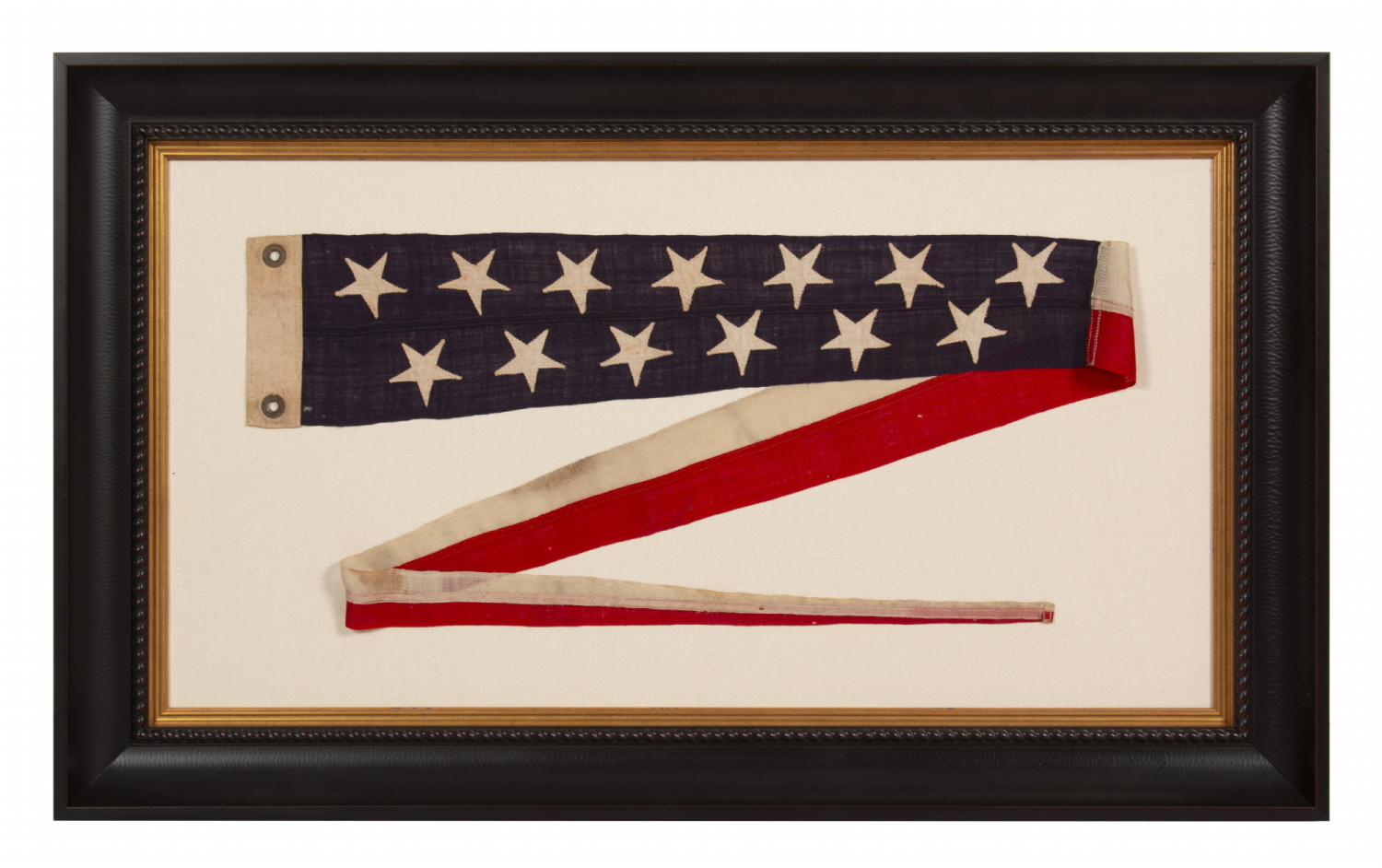


| 6-FOOT SHIP’S COMMISSION PENNANT WITH A 5.5” HOIST AND 13 STARS IN 2 STAGGERED ROWS, LIKELY PRODUCED FOR A PRIVATE VESSEL, circa 1892-1910 |
|
| Web ID: | 13j-1719 |
| Available: | In Stock |
| Frame Size (H x L): | 22" x 36.5" |
| Flag Size (H x L): | 5.5" x 71.25" (unfurled) |
| Description: | |
| Commission pennants are the distinguishing mark of a commissioned U.S. Navy ship. Termed “narrow pennants” by the U.S. Navy in mid-19th century regulations, and flown at the topmast, the typical American format is a long blue field, usually with a single row of white stars, although sometimes with their total divided into two rows, followed by two long stripes in red-over-white. A ship became commissioned when this pennant was hoisted. Flown during both times of peace and war, the only time the pennant is not flown is if a flag officer or civilian official was aboard and replaced it with their own flag. Sometimes the owners of private ships mimicked the use of Navy signals. Some seafaring men would have served in the Navy and, in such capacity, become privy to Navy practice, procedures, and traditions. Some private ships flew commission pennants for purely stylistic reasons, either on a regular basis or while the boat was dressed for special occasions. Hudson River steamers regularly flew pennants of this nature, as well as many other stylish flags and banners, as evidenced by both period photographs and the ship paintings of artists such as John & James Bard. Mississippi riverboats likely flew them as well, as did many yachts and other private craft. Probably made sometime between roughly 1892 and 1910, this particular commission pennant was produced by a commercial maker. It is an unusual one, in a size that I have not previously owned. Though the overall length of 6 feet was typical, appearing on all 19th century Navy regulations in which they were specified, the hoist measurements of a 6-foot pennant was consistently 2.5 inches. Though the star count wasn’t specified until 1912, when it was designated to be a count of 7, the length of the blue union remained 1.5 feet from 1854 - 1912 [though for some reason unspecified in 1899 regs]. Though no one knows the reason for the use of the 7 star count, the unwavering length of the union in navy regulations suggests that it may have been 7 all along. Surviving examples of this length that pre-date the 1900 are so few in number that it’s difficult to know if this was true, or even if the use of a particular number was important. At 5.5 inches on the hoist, and with a count of 13 stars, arranged in 2 rows, in counts of 7 over 6, the pennant that is the subject of this narrative is both more than twice the expected height, and bears a star count usually reserved for longer examples. The canton and stripes of the pennant are made of wool bunting that has been pieced-and-sewn by machine. The stars are made of cotton and are double-appliquéd (applied to both sides) with a zigzag, machine stitch. There is a twill cotton binding along the hoist, with two brass grommets. While all commission pennants taper in some fashion from hoist to fly, many terminate in a forked swallowtail. Others, such as this example, narrow to a blunt or pointed tip. Mounting: For 25 years we have maintained a specialized department for this purpose. Our lead conservator holds a master's degree in textile conservation from one of the nation’s top university programs. We take great care in the mounting and preservation of flags and related textiles and have preserved thousands of examples. The background fabric is 100% hemp fabric, ivory in color, with a twill weave. Three-dimensional folds were added in the stripes. The mount was placed in a deep, cove-shaped molding with a very dark brown surface, nearly black, and a rope-style inner lip, to which a gilded, step-down profile molding was added as a liner. The glazing is U.V. protective acrylic (Plexiglas). Condition: There is minor soiling along the hoist binding and in the stars, accompanied by minor soiling in the white stripe, where there are a couple of instances of more significant staining. There is extremely minor mothing. Many of my clients prefer early flags to show their age and history of use. |
|
| Video: | |
| Collector Level: | Intermediate-Level Collectors and Special Gifts |
| Flag Type: | Sewn flag |
| Star Count: | 13 |
| Earliest Date of Origin: | 1892 |
| Latest Date of Origin: | 1910 |
| State/Affiliation: | 13 Original Colonies |
| War Association: | |
| Price: | Please call (717) 676-0545 or (717) 502-1281 |
| E-mail: | info@jeffbridgman.com |
 |
|